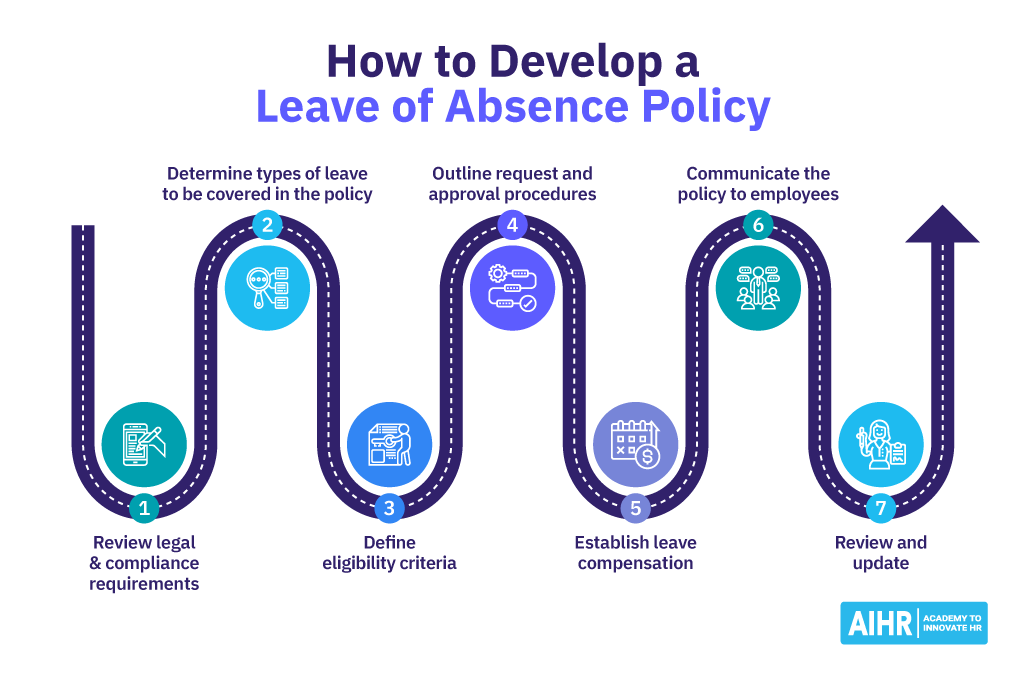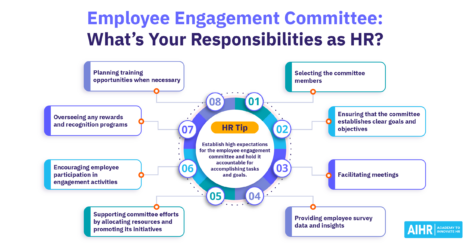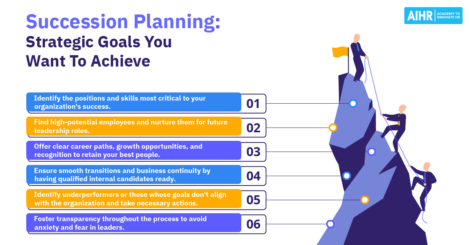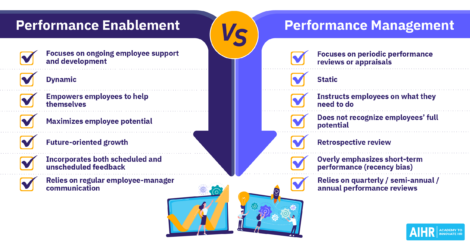How To Craft a Leave of Absence Policy (in 2024)

A robust leave of absence policy is vital for your organization to run smoothly and adequately cater to employees’ need for time off work. A fair and consistent leave of absence policy can aid employees who require time off for medical, family, or personal reasons. On the other hand, it can also ensure that employees do not take advantage of leniency to miss work.
This article will cover best practices and considerations for creating a leave of absence policy that satisfies your organization’s and workers’ needs. To assist you in creating a successful policy, we’ll discuss eligibility, forms of leave, paperwork, and communication.
Contents
The leave of absence policy explained
Benefits of having a leave of absence policy
How to develop a leave of absence policy
Company examples of leave of absence policies
The leave of absence policy explained
Employees may need to take time off work occasionally to rejuvenate or attend to personal matters while retaining their employment status. This is where the leave of absence comes into play. It’s a set of guidelines and procedures determining how employees can take time off and for which reasons.
As such, a leave of absence policy outlines the types of leave absence available, eligibility criteria, documentation requirements, and the steps employees need to take to request leave.
The most common types of leave and what they usually involve include:
- Jury duty leave: In most cases, employers must let workers take unpaid time off for jury service. Employees may or may not be paid during this period, and the absence’s length depends on how long the trial lasts.
- Voting leave: In certain places, companies must provide workers time off on Election Day so they can cast their ballots. Depending on the state and the employer’s policy, this time may be compensated or uncompensated.
- Bereavement leave: Employees who have experienced the death of a close family member are often eligible for this form of absence. The length of the leave varies depending on the company and the employee’s link to the deceased.
- Vacation leave: Employees can take time off work for leisure and recreation during vacation periods.
- Sick leave: Employees who are ill or injured are given time off to heal.
- Parental leave: Whether a kid is born, adopted, or placed in foster care, parental leave enables employees to take time off work to care for a new child.
- Annual leave: Like vacation time, yearly leave enables employees to take time off for leisure and recreation.
- Medical leave: Medical leave gives workers time off to take care of a significant health issue that they, a family member, or another person in their care is experiencing.
Benefits of having a leave of absence policy
Organizations and workers benefit from leave of absence policies. A good leave of absence policy has several benefits:
- Clear guidelines: A leave of absence policy outlines processes for employees taking time off. This prevents misunderstandings by setting expectations.
- Compliance with laws and rules: A leave of absence policy guarantees that the firm complies with all applicable employee leave laws and regulations, such as the FMLA in the US. This helps you avoid legal complications and fines.
- Increased morale and productivity: Employees feel valued and driven when their employer supports their personal needs. This increases job happiness, productivity, and retention.
- Minimize employee fatigue: Allowing employees to take time off when required helps reduce burnout. This reduces stress and improves mental wellness, improving job performance.
- Fairness and consistency: A leave policy ensures justice and consistency in employee leave requests. This can prevent bias.
- Expense savings: A well-managed leave policy may minimize absenteeism and turnover costs. The company may decrease stress, burnout, and employee turnover by supporting time-off requests.
Even without the benefits, not having a leave policy might harm the company and its employees. Without clear standards, employees may feel confused and frustrated, and you may be legally liable. Inconsistency in leave requests might sometimes lead to partiality or discrimination.
Lastly, without a leave of absence policy, absenteeism, productivity, and turnover might increase, hurting the company’s bottom line. With all these, your organization faces risks such as:
- Legal risks: Without a policy, a business may be sued by absentee workers who feel mistreated. Discrimination, wrongful termination, and employment law infractions are examples.
- Non-compliance: Penalties, fines, and legal expenses can come from a leave of absence policy that violates federal, state, and municipal regulations.
- Reduced employee retention: Employees who feel unsupported at times of need may quit the company, increasing turnover and expenses.
- Inconsistent employee treatment: Managers may handle leave requests differently without a defined guideline, resulting in discrepancies and prejudices.
- Business disruption: Unclear leave rules might cause company interruptions.

How to develop a leave of absence policy
Any company that cares about its workers and follows the law must have a thorough leave of absence policy. HR should follow these steps to create a leave of absence policy that fulfills the organization’s needs and follows best practices.
1. Review legal and compliance requirements
HR must comprehend legal and regulatory requirements before creating a leave of absence policy. While doing so, ensure you cover federal, state, and municipal leave of absence policies. Some of the frameworks you should review include FMLA and ADA.
As your HR team works to develop the policies, ensure it collaborates with your legal department to verify if the policy is lawful and up-to-date with current legislative developments. HR should also ensure their policy matches corporate standards like anti-discrimination and anti-harassment.
HR tip
To minimize legal issues, keep up with legal and regulatory standards. Assessing legal and compliance criteria frequently can help keep the leave of absence policy lawful and up-to-date.
2. Determine types of leave to be covered in the policy
As mentioned, regulations dictate that organizations offer various types of leave to employees. These leave options include:
- Sick leave
- Grief leave
- Vacation leave
- Juror leave
- Voting leave
- Parental leave
- Annual leave
- Medical leave
HR tip
Consider employee and business needs while choosing policy leave kinds. Balance employee and company needs.
3. Define eligibility criteria
Offering the required types of leave is one of the best ways of taking care of your employees. However, you need to have pre-determined qualification criteria. This prevents misunderstandings and disagreements by ensuring staff understand leave obligations.
When determining leave of absence eligibility, consider the following:
- Duration of service: Several companies demand workers work for a particular period before taking leave.
- Full-time vs. part-time status: Leave eligibility may vary by position.
- Employment classification: Some companies restrict leave to specific job categories or divisions.
- Reason for leave: Medical or parental leave may also determine eligibility.
HR tip
HR should explain policy eligibility requirements to workers. The criteria must also meet legal and regulatory constraints.
4. Outline request and approval procedures
HR should establish leave request and approval procedures after determining categories and eligibility. This includes the leave request process, notice period, and associated papers. Clear and straightforward processes prevent confusion.
You can also enhance this process by using leave management systems to automate leave requests. Such a system will help you speed up leave requests and approvals while eliminating human bias. Moreover, HR may use a leave management system to track employee leave balances and prevent overuse.
HR should also plan for sudden leave requests, including illness or family emergencies. Clear standards for these instances can help prevent workplace disturbances.
HR tip
Train managers and supervisors to handle leave requests and enforce the leave of absence policy. This can assist in streamlining the procedure across the company.
5. Establish leave compensation
Regarding matters of leave, compensation is one of the major areas of contention. Depending on the nature, reason, and duration of leave, you may be obliged or choose to compensate employees. However, the compensation offered should not be determined upon each request.
If you decide to compensate employees, have clear guidelines on how it will be done and the factors to be considered. Of course, you should also account for the organization’s finances while determining this.
HR tip
Let employees on leave combine paid time off (PTO) or vacation time with unpaid absence to ease the financial strain. Avoid employee disagreements by explicitly stating the payment choices in the policy.
6. Communicate the policy to employees
Communicating a complete leave of absence policy to employees is crucial. This step helps minimize future misunderstandings and disagreements by informing employees of their policy rights and responsibilities.
Here are some communication tips:
- Put the policy in the employee handbook: Employees use the handbook to understand corporate rules, including leave of absence. Make sure the policy is accessible and worded clearly.
- Hold training sessions: Train managers and staff to understand and use the policy. This prevents policy misunderstanding and ensures consistency.
- Use multiple communication channels: Communicate via email, corporate intranet, posters, and newsletters to inform all workers of the policy.
- Give a point of contact: Workers should have a company contact to handle policy inquiries. That might be HR or a manager.
- Review periodically: The policy should be reviewed and modified often to stay current with legal and corporate developments.
HR tip
HR should clearly explain the policy to workers to promote a healthy work atmosphere and reduce legal issues.
7. Review and update
Regulations on employee leave change from time to time. When this happens, organizational needs and employee input also change. Therefore, after communicating a leave of absence policy to employees, ensure you review and update it as needed.
Tips for examining and modifying a leave policy:
- Monitor changes to the Family and Medical Leave Act (FMLA), and state leave legislation.
- Ask employees about policy efficacy and areas for improvement.
- Evaluate how business or industry changes or rival employee benefits packages may affect the policy.
- Consult legal or HR experts to maintain policy compliance and efficacy.
HR tip
HR should continuously examine and update the leave of absence policy to meet the business’s and its workers’ demands and comply with regulatory obligations.
Company examples of leave of absence policies
As you develop your leave of absence policy, you must learn from the companies excelling in this area. Some of the firms that have good leave policies include:
Microsoft: Microsoft offers 12 weeks of paid parental leave for both parents and four weeks of paid caregiver leave for immediate family members with significant health conditions. They give up to four weeks of bereavement leave, flexible work options, and personal leave.
Patagonia: Patagonia offers 16 weeks of paid family leave for the birth or adoption of a child and 12 weeks for caregiving or personal medical reasons. They also give up to two weeks of paid bereavement leave and unpaid personal leave.
Salesforce: Both parents receive 26 weeks of paid parental leave and up to 6 weeks to care for a family member with a severe illness. They also give up to 3 days of paid bereavement leave and unpaid personal leave.
These firms provide competitive leave policies and promote employee well-being. As you can see, your HR team must consider employee requirements and industry norms when creating the policy.
Key takeaways
Safeguarding the wellbeing of your employees is essential for long-term organizational growth. This is why developing a leave of absence policy is vital. It allows you to cater to their needs while preventing the misuse of company goodwill. Here are some of the key takeaways.
- Every company needs a leave of absence policy to protect employees and comply with laws.
- HR should review legal and compliance requirements, determine the types of leave to be covered, define eligibility criteria, establish compensation, outline request and approval procedures, communicate the policy to employees, and review and update the policy regularly to create a comprehensive leave of absence policy.
- Companies can model their leave arrangements after others.
- A well-crafted leave of absence policy may minimize legal concerns, promote compliance, improve employee morale and productivity, and reduce employee fatigue.
As you work towards building a better workplace, AIHR is a partner you can count on. We offer tons of courses and training to enhance your HR capabilities. So, try AIHR today to empower your HR team to lead your organization forward.
Weekly update
Stay up-to-date with the latest news, trends, and resources in HR
Learn more
Related articles
Are you ready for the future of HR?
Learn modern and relevant HR skills, online












